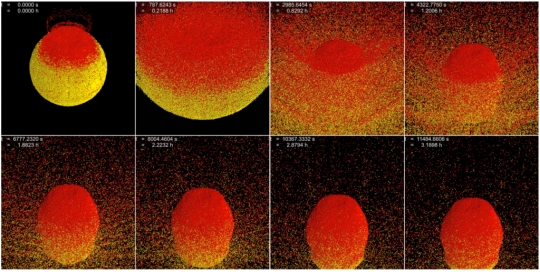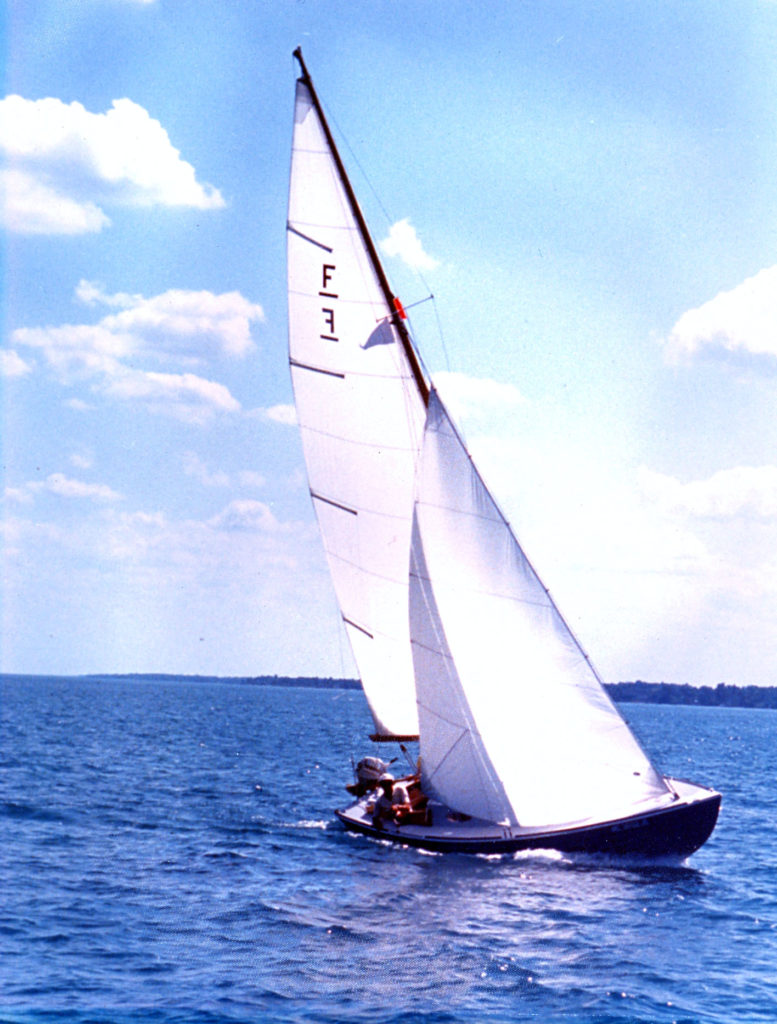This column first ran in The Tablet in July 2007; we first ran it here in 2015.
In Alicante, on Spain’s Mediterranean coast, a group of us planetary astronomers held a workshop [in 2007] on how asteroids respond to the massive collisions that can lead to their catastrophic disruption. Just north of us, in Valencia, sailors from Switzerland and New Zealand were vying for the America’s Cup.
The connection between elegant million dollar yachts and exploding asteroids. is the equations of fluid dynamics.
I’ve loved sailing since my childhood. I spent my summers capsizing sailboards on Lake Huron and my winters reading too much Arthur Ransome. As a student in the early 1970s I competed on MIT’s sailing team (the Charles River was indeed “dirty water” especially back then), and attended lectures in their ocean engineering department on the challenges of designing the best shape for a hull that could slip through the water with a minimum of friction while still providing the resistance to leeward slip that lets a sailboat claw its way into the wind. The America’s Cup has long been powered by design advances, and intrigue, as teams compete to keep their own secrets while spying out the advances of their opponents.
There are rivalries in the planetary science community as well, but our field has been more cooperative than competitive sailors. The [July 2007] workshop centered around comparing different computer codes for modeling what happens when two asteroids, perhaps a hundred kilometers across, collide at speeds approaching a hundred thousand kilometers per hour. No experiment can reproduce such conditions, but at least in the lab we can begin to measure things like the mechanical properties of rock, and try to estimate at what point the force of gravity is more important than the strength of the rock in holding the asteroid together in the face of such collisions. At that point, the rock flows like a fluid and computer hydrocodes can be invoked that solve the same equations used by sailboat designers – but under very different conditions.
 A 2019 model from one of the research groups who presented back in 2007… A frame-by-frame showing how gravity causes asteroid fragments to reaccumulate in the hours following impact. Credit: Charles El Mir/Johns Hopkins University.
A 2019 model from one of the research groups who presented back in 2007… A frame-by-frame showing how gravity causes asteroid fragments to reaccumulate in the hours following impact. Credit: Charles El Mir/Johns Hopkins University.Two fascinating new results from this workshop have given us reason to question our results to date. A classic assumption has been that collisions need to reach a certain minimum energy before asteroids will break apart; but lab experiments now suggest that rock can accumulate damage over many impacts, so that (for example) after nine previous collisions, each with a tenth of the disruptive energy, an asteroid can be set up to fall apart with the tenth such impact. One could draw a moral analogy, perhaps: though a thousand venial sins don’t add up to one mortal sin, they certainly weaken your moral fibre enough to make you more susceptible to catastrophic failure when a stronger challenge comes along!
Another disquieting result for the computer modelers was the confession from a long-standing guru that his code, solving the motions of a hundred thousand points inside a model asteroid, turns out not to be nearly detailed enough. He suspects now that tens of millions of points need to be followed, which requires a degree of computing power that no lab has – yet.
The challenge comes from the nature of fluid flow. We know the equations; but we can’t solve them directly. Computers can only approximate them, and a slight error in our starting guesses can change the outcome completely. It’s what makes the weather so hard to predict. It’s what keeps us puzzling over the formation, and disruption, of planets. And it’s one reason, of course, why we actually need to build the boats and race them.
Of course, that’s the least of the reasons. There are other intellectual puzzles, and faster ways to move through water. But the urge to know about the formation of the planets, like the urge to sail, comes ultimately from the human heart. Success in both comes from human judgments as much as from clever calculations. And the race is won by whoever best approachs the pattern of the One who gave us sea and sky.
I don’t get to do much sailing nowadays…

